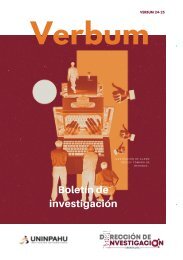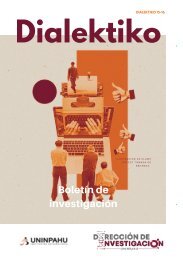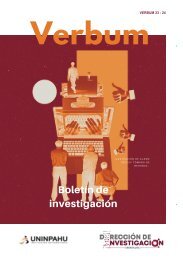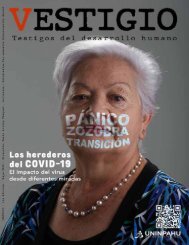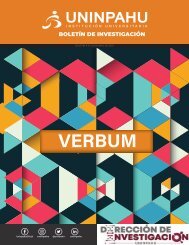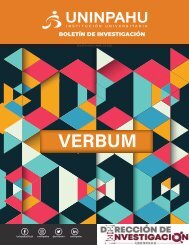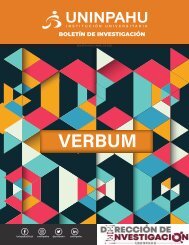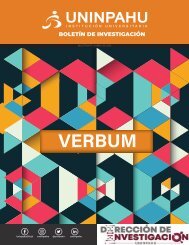Revista UNINPAHU No 9
Revista de investigación UNINPAHU No 9
Revista de investigación UNINPAHU No 9
Create successful ePaper yourself
Turn your PDF publications into a flip-book with our unique Google optimized e-Paper software.
28 Pp 23 - 31. Nº 9, octubre de 2013<br />
en serio toda la investigación y todo. Entonces<br />
fue como un gran avance.” 11 (Final Interview)<br />
It is significant the way in which these<br />
students experienced the touch of the past.<br />
Josefina declares that seeing the telegram<br />
was a confirmation that Saturio’s story was<br />
real because until that point she, like other<br />
students, still thought it was an invented story,<br />
“algo imaginario” 12 . In Josefina’s case the touch<br />
of the past becomes more a substantiation, an<br />
evidential rather than a sensory experience.<br />
The reality of the past is revealed here through<br />
a personal and factual contact with a proof<br />
from the past that talks about concrete events<br />
taking place in specific times and places. In<br />
other words, to see the telegram translates into<br />
a validation of Saturio’s account, proof for the<br />
students that Saturio’s life really took place in<br />
a space and time. I suggest interpreting this<br />
turn as an acceptance of Saturio’s historical<br />
existence, that his life was part of the social<br />
time of the human, and more specifically part<br />
of our collective past.<br />
Similarly, Mercedes remarks that they did not<br />
even believe the telegram existed, but instead<br />
it was made up. Carlos recalls that clearing up<br />
doubts about the existence and truth of our<br />
drama-remembrance process pre-text, Saturio’s<br />
story, helped the research. Both students<br />
highlight the positive consequence of this<br />
discovery in the development of their research.<br />
It helped to move the project on; “fue como un<br />
gran avance” 13 . It is telling to realize that at this<br />
level, at this point of the research, after all our<br />
previous drama exploration work, they did<br />
not yet believe the telegram and Saturio’s story<br />
happened and hence had historical existence.<br />
Reflecting on this, I think that for students<br />
to confirm that the telegram and Saturio’s<br />
story were historically real was important in<br />
terms of the formation of a public memory<br />
consciousness. Finding out that Saturio was<br />
real, that his story and life events took place<br />
in a specific location and time span of our<br />
collective memory, was important not only as<br />
meaningful historical knowledge but in terms<br />
of the historical awareness this knowledge<br />
generates. This is an important point in regard<br />
to the work of memory understood in terms of<br />
recovering of the past, overcoming historical<br />
oblivion and the formation of a critical historical<br />
consciousness; “nos tomamos mas en serio toda la<br />
investigación”. 14<br />
There were other trajectories within which<br />
Montessori students experienced the touch<br />
of the past during their visit to the Colombian<br />
History Archive. Other participants took<br />
different directions, different routes in their<br />
encounter with the paths of the past: learning<br />
through the past. Learning through the past is<br />
a pedagogical experience that involves both the<br />
learning of the past and the learning from the<br />
past. We learn about the past when we get to<br />
know the events of the past and when we pay<br />
attention to the telling of the past.<br />
Important history and disciplinary learning,<br />
powerful encounters with traces of the past,<br />
and deep individual and collective involvement<br />
constituted the main pedagogical components<br />
of the Colombian National History Archive<br />
experience. Alvaro, 16 years old, and Beatriz,<br />
15 years old, commented:<br />
(11) “It meant so much cause to have the opportunity to take in our hands the telegram was so strange, cause we never<br />
thought we could have the telegram like that, we always saw it in photocopies and you gave it to us but we never had<br />
it right there in our hands, we never thought like holding it, to tell the truth. Simply we thought it was just a photocopy<br />
and that’s it. And most of us didn’t believe that it was written by someone, instead that it was just invented. To tell the<br />
truth we didn’t even think the telegram was real. When we could see it and everything at the National Archive, well it<br />
was different because we then took more seriously the research and everything. It was like a big advance”.<br />
(12) “something imaginary”<br />
(13) “it was like a big advance”<br />
(14) “we then took more seriously the research”




